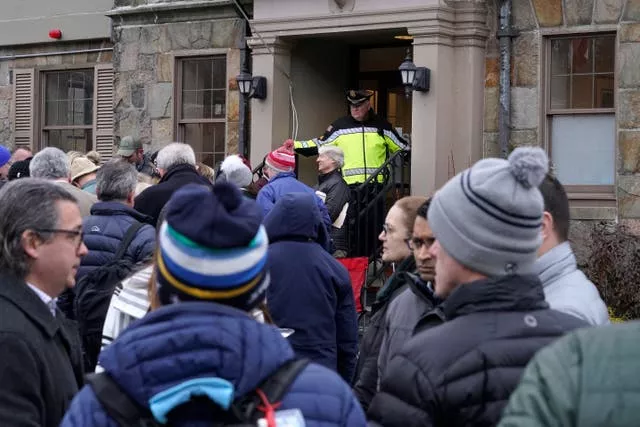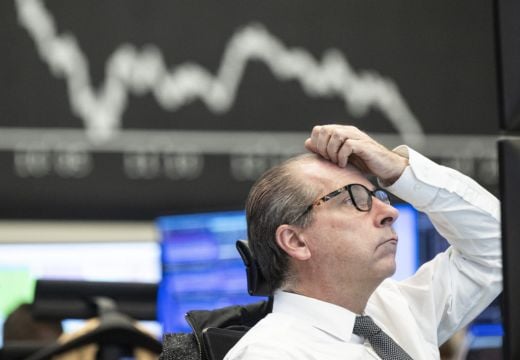Fear is gripping Wall Street about what will be next to topple following the second- and third-largest bank failures in US history.
Stocks fell early on Monday and US Treasury yields are also falling sharply as investors scramble to find somewhere safe to park their money.
The S&P 500 was 1.1 per cent lower, with the heaviest losses coming from banks.
Investors are worried that a relentless rise in interest rates meant to get inflation under control have hit a tipping point and are cracking the banking system and broader economy.

US regulators announced a plan late on Sunday meant to shore up the banking industry following the collapses of Silicon Valley Bank and Signature Bank since Friday.
Most of the pressure is being heaped on the regional banks one or two steps down in size from the massive, “too-big-to-fail” banks that helped take down the economy during the 2008 financial crisis.
Shares of First Republic plunged 66.9 per cent, even after the bank said on Sunday it had strengthened its finances with cash from the Federal Reserve and JPMorgan Chase.
Analysts at ING said: “So far, it seems that the potential problem banks are few, and importantly do not extend to the so-called systemically important banks.”
The broader market was holding up a bit better as expectations built that the all the chaos means the Fed would have to take it easier on its economy-rattling hikes to interest rates.
The Dow Jones Industrial Average was down 125 points, or 0.4 per cent, at 31,784 as of 9.45am Eastern time (1.45pm Irish time), while the Nasdaq composite was 1.2 per cent lower.
Treasury, @federalreserve, & @FDICgov released a joint statement on decisive actions taken today to protect the U.S. economy and ensure that the U.S. banking system continues its vital role of protecting deposits. https://t.co/q2lqREuGDw
Advertisement— Treasury Department (@USTreasury) March 12, 2023
Stock markets were mixed in Asia after the US government announced its plan to protect depositors at banks, but the losses deepened as trading headed westward through Europe.
A measure of fear among stock investors on Wall Street touched its highest level since October.
Among the few investments to climb in price was gold, as investors looked for anything that seemed safe. It rose 2.1 per cent to $1,906.10 per ounce.
Prices for US Treasury Securities also shot higher on both demand for something safe and expectations for an easier Fed.
That in turn sent their yields lower, and the yield on the 10-year Treasury plunged to 3.46 per cent from 3.70 per cent late Friday. That marks a major move for the bond market. It was above 4 per cent earlier this month.
The two-year yield, which moves more on expectations for the Fed, had an even more breathtaking drop. It fell to 4.09 per cent from 4.59 per cent Friday.
Silicon Valley Bank UK has today been sold to @HSBC.
This transaction has been facilitated by the @bankofengland in consultation with HM Treasury.
No taxpayer money is involved and customer deposits have been protected.
Find out more ⬇️https://t.co/Dmfjdx7duC— HM Treasury (@hmtreasury) March 13, 2023
Some investors are calling for the Fed to make emergency cuts to interest rates soon to stanch the bleeding. The wider expectation, though, is that the Fed will likely pause or slow its increases.
Traders are betting on a nearly four-in-five chance that the Fed will hike its key overnight interest rate by 0.25 percentage points later this month at its next meeting. They are also now betting on a 21% chance that it will hold steady, according to CME Group.
But even that is a sharp turnaround from earlier last week, when many traders were betting on the Fed reaccelerating its hikes and increasing by 0.50 percentage points because of how stubbornly sticky high inflation has been.
Higher interest rates can drag down inflation by slowing the economy, but they raise the risk of a recession later on. They also hit prices for stocks, as well as bonds already sitting in investors’ portfolios.
That latter effect is one of the reasons for the worries about the banking system. The Fed began hiking interest rates almost exactly a year ago, and it has instituted the sharpest flurry in decades. Its key overnight rate is now at a range of 4.50 per cent to 4.75 per cent, up from virtually zero.
That has hurt the investment portfolios of banks, which often park their cash in Treasuries because they are considered among the safest investments on Earth.

The collapse of Silicon Valley Bank has reverberated around the world.
Germany’s financial regulator, BaFin, prohibited asset disposals and payments by Silicon Valley Bank’s German branch and imposed a moratorium, effectively shutting it for dealings with customers.
In a statement, BaFin stressed that the German branch does not constitute a threat to financial stability.
BaFin said SVB’s German branch was responsible for lending but did not run a deposit business in the country, so deposit insurance is not an issue.
Before trading began in Asia, the US Treasury Department, Federal Reserve and Federal Deposit Insurance said on Sunday that all Silicon Valley Bank clients will be protected and have access to their funds and announced steps designed to protect the bank’s customers and prevent more bank runs.
Regulators on Friday closed Silicon Valley Bank as investors withdrew billions of dollars from the bank in a matter of hours, marking the second-largest US bank failure behind the 2008 failure of Washington Mutual.
They also announced on Sunday that New York-based Signature Bank was being seized after it became the third-largest bank to fail in US history.







